Lack of Knowledge About Advanced Nurse Practitioners Among Physicians
VerifiedAdded on 2023/04/22
|59
|11894
|444
Thesis and Dissertation
AI Summary
This dissertation investigates the lack of knowledge, understanding, and awareness among physicians in Saudi Arabia regarding the role of Advanced Nurse Practitioners (ANPs). It explores the historical context of ANPs, their educational requirements, and physician perceptions, utilizing the Knowledge to Action (KTA) framework to address the knowledge gap. The research aims to assess physician perceptions of ANPs in Saudi Arabia, examining the challenges and barriers to ANP integration within the healthcare system. The study includes a literature review, methodology, data analysis, and discussion of findings, ultimately aiming to improve healthcare organization and patient outcomes by clarifying the role and scope of practice for ANPs in the Saudi Arabian healthcare context. The research uses pre and post training surveys to quantify the change in perception after an intervention.
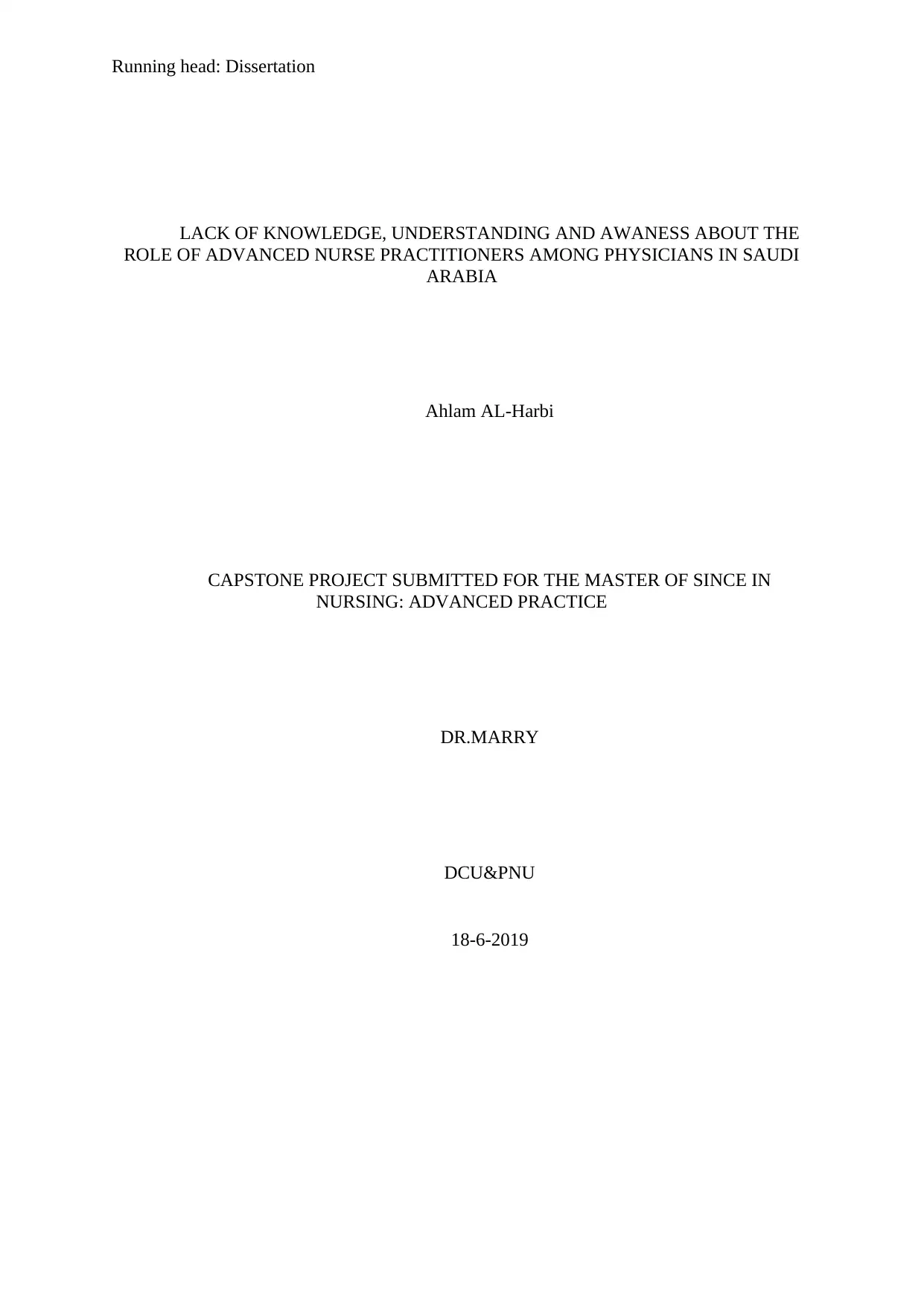
Running head: Dissertation
LACK OF KNOWLEDGE, UNDERSTANDING AND AWANESS ABOUT THE
ROLE OF ADVANCED NURSE PRACTITIONERS AMONG PHYSICIANS IN SAUDI
ARABIA
Ahlam AL-Harbi
CAPSTONE PROJECT SUBMITTED FOR THE MASTER OF SINCE IN
NURSING: ADVANCED PRACTICE
DR.MARRY
DCU&PNU
18-6-2019
LACK OF KNOWLEDGE, UNDERSTANDING AND AWANESS ABOUT THE
ROLE OF ADVANCED NURSE PRACTITIONERS AMONG PHYSICIANS IN SAUDI
ARABIA
Ahlam AL-Harbi
CAPSTONE PROJECT SUBMITTED FOR THE MASTER OF SINCE IN
NURSING: ADVANCED PRACTICE
DR.MARRY
DCU&PNU
18-6-2019
Paraphrase This Document
Need a fresh take? Get an instant paraphrase of this document with our AI Paraphraser
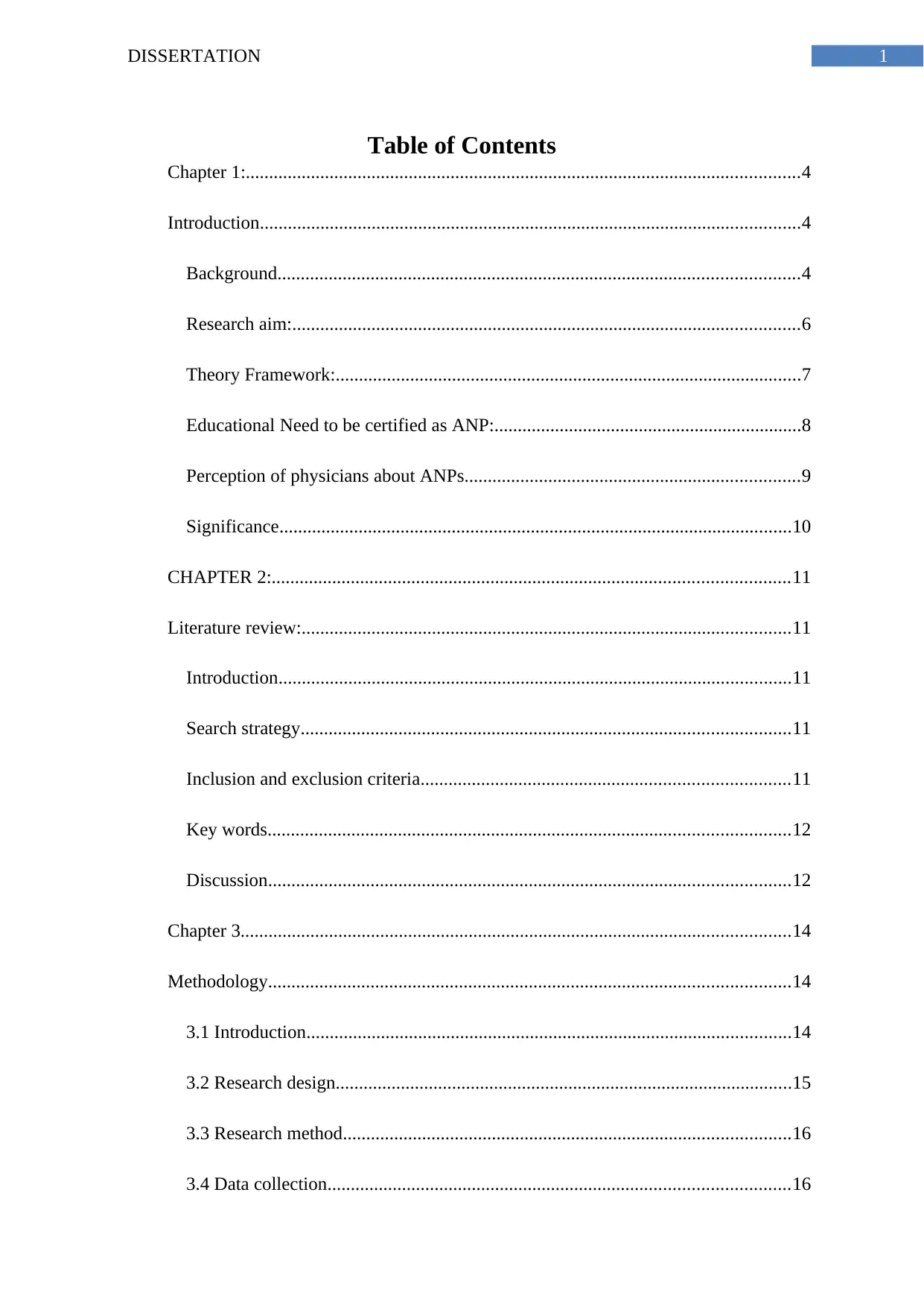
1DISSERTATION
Table of Contents
Chapter 1:.......................................................................................................................4
Introduction....................................................................................................................4
Background................................................................................................................4
Research aim:.............................................................................................................6
Theory Framework:....................................................................................................7
Educational Need to be certified as ANP:..................................................................8
Perception of physicians about ANPs........................................................................9
Significance..............................................................................................................10
CHAPTER 2:...............................................................................................................11
Literature review:.........................................................................................................11
Introduction..............................................................................................................11
Search strategy.........................................................................................................11
Inclusion and exclusion criteria...............................................................................11
Key words................................................................................................................12
Discussion................................................................................................................12
Chapter 3......................................................................................................................14
Methodology................................................................................................................14
3.1 Introduction........................................................................................................14
3.2 Research design..................................................................................................15
3.3 Research method................................................................................................16
3.4 Data collection...................................................................................................16
Table of Contents
Chapter 1:.......................................................................................................................4
Introduction....................................................................................................................4
Background................................................................................................................4
Research aim:.............................................................................................................6
Theory Framework:....................................................................................................7
Educational Need to be certified as ANP:..................................................................8
Perception of physicians about ANPs........................................................................9
Significance..............................................................................................................10
CHAPTER 2:...............................................................................................................11
Literature review:.........................................................................................................11
Introduction..............................................................................................................11
Search strategy.........................................................................................................11
Inclusion and exclusion criteria...............................................................................11
Key words................................................................................................................12
Discussion................................................................................................................12
Chapter 3......................................................................................................................14
Methodology................................................................................................................14
3.1 Introduction........................................................................................................14
3.2 Research design..................................................................................................15
3.3 Research method................................................................................................16
3.4 Data collection...................................................................................................16
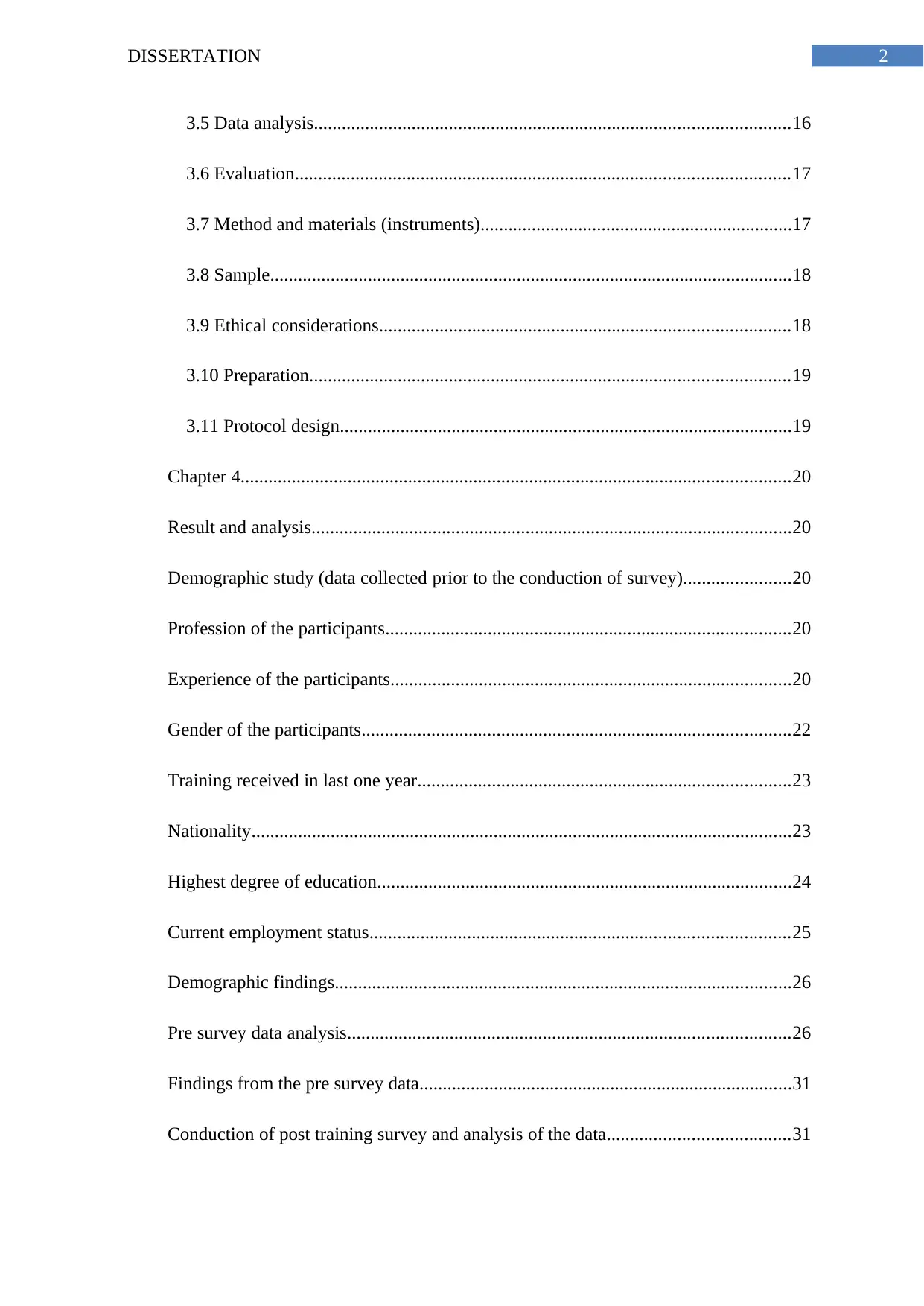
2DISSERTATION
3.5 Data analysis......................................................................................................16
3.6 Evaluation..........................................................................................................17
3.7 Method and materials (instruments)...................................................................17
3.8 Sample................................................................................................................18
3.9 Ethical considerations........................................................................................18
3.10 Preparation.......................................................................................................19
3.11 Protocol design.................................................................................................19
Chapter 4......................................................................................................................20
Result and analysis.......................................................................................................20
Demographic study (data collected prior to the conduction of survey).......................20
Profession of the participants.......................................................................................20
Experience of the participants......................................................................................20
Gender of the participants............................................................................................22
Training received in last one year................................................................................23
Nationality....................................................................................................................23
Highest degree of education.........................................................................................24
Current employment status..........................................................................................25
Demographic findings..................................................................................................26
Pre survey data analysis...............................................................................................26
Findings from the pre survey data................................................................................31
Conduction of post training survey and analysis of the data.......................................31
3.5 Data analysis......................................................................................................16
3.6 Evaluation..........................................................................................................17
3.7 Method and materials (instruments)...................................................................17
3.8 Sample................................................................................................................18
3.9 Ethical considerations........................................................................................18
3.10 Preparation.......................................................................................................19
3.11 Protocol design.................................................................................................19
Chapter 4......................................................................................................................20
Result and analysis.......................................................................................................20
Demographic study (data collected prior to the conduction of survey).......................20
Profession of the participants.......................................................................................20
Experience of the participants......................................................................................20
Gender of the participants............................................................................................22
Training received in last one year................................................................................23
Nationality....................................................................................................................23
Highest degree of education.........................................................................................24
Current employment status..........................................................................................25
Demographic findings..................................................................................................26
Pre survey data analysis...............................................................................................26
Findings from the pre survey data................................................................................31
Conduction of post training survey and analysis of the data.......................................31
⊘ This is a preview!⊘
Do you want full access?
Subscribe today to unlock all pages.

Trusted by 1+ million students worldwide
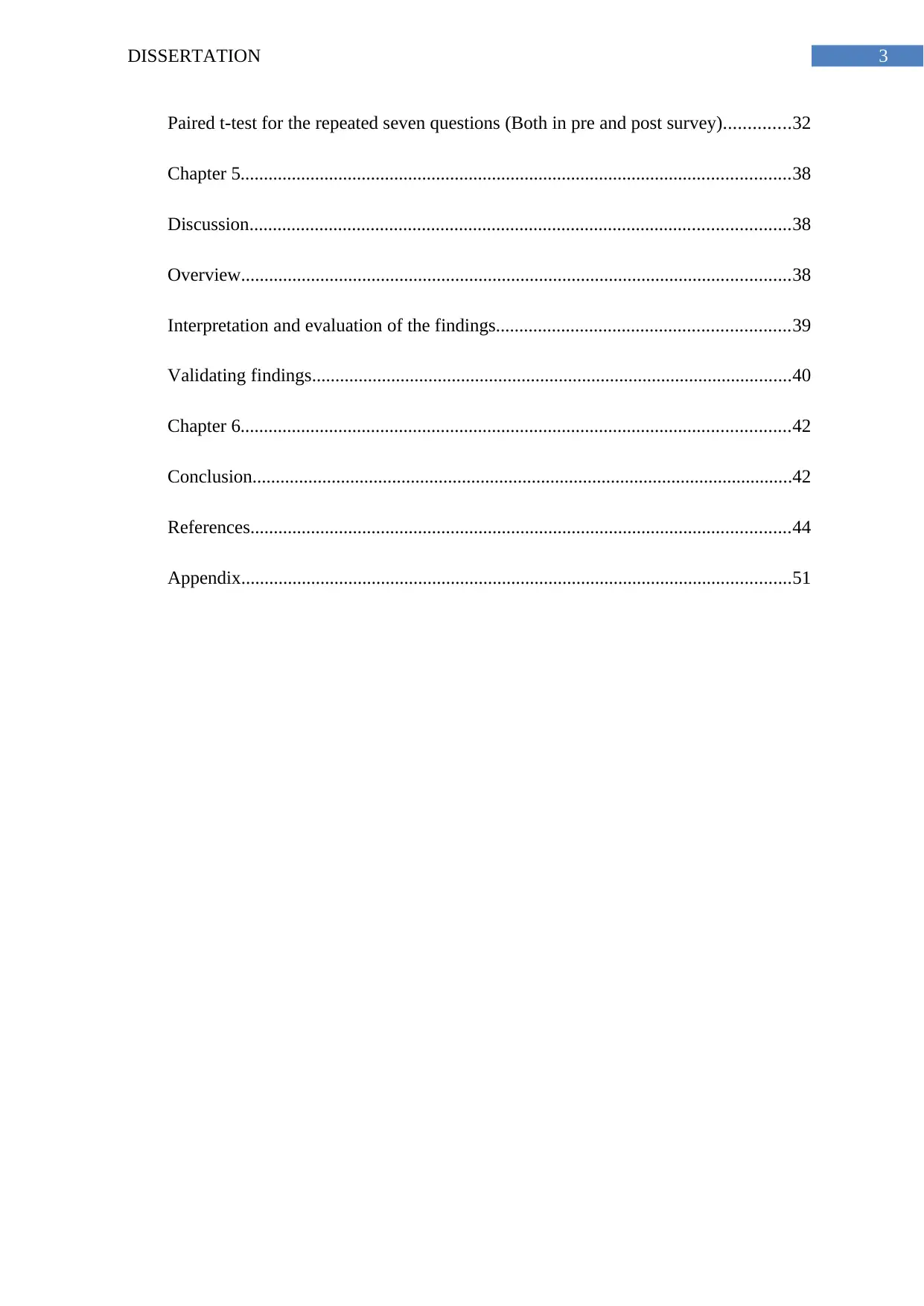
3DISSERTATION
Paired t-test for the repeated seven questions (Both in pre and post survey)..............32
Chapter 5......................................................................................................................38
Discussion....................................................................................................................38
Overview......................................................................................................................38
Interpretation and evaluation of the findings...............................................................39
Validating findings.......................................................................................................40
Chapter 6......................................................................................................................42
Conclusion....................................................................................................................42
References....................................................................................................................44
Appendix......................................................................................................................51
Paired t-test for the repeated seven questions (Both in pre and post survey)..............32
Chapter 5......................................................................................................................38
Discussion....................................................................................................................38
Overview......................................................................................................................38
Interpretation and evaluation of the findings...............................................................39
Validating findings.......................................................................................................40
Chapter 6......................................................................................................................42
Conclusion....................................................................................................................42
References....................................................................................................................44
Appendix......................................................................................................................51
Paraphrase This Document
Need a fresh take? Get an instant paraphrase of this document with our AI Paraphraser
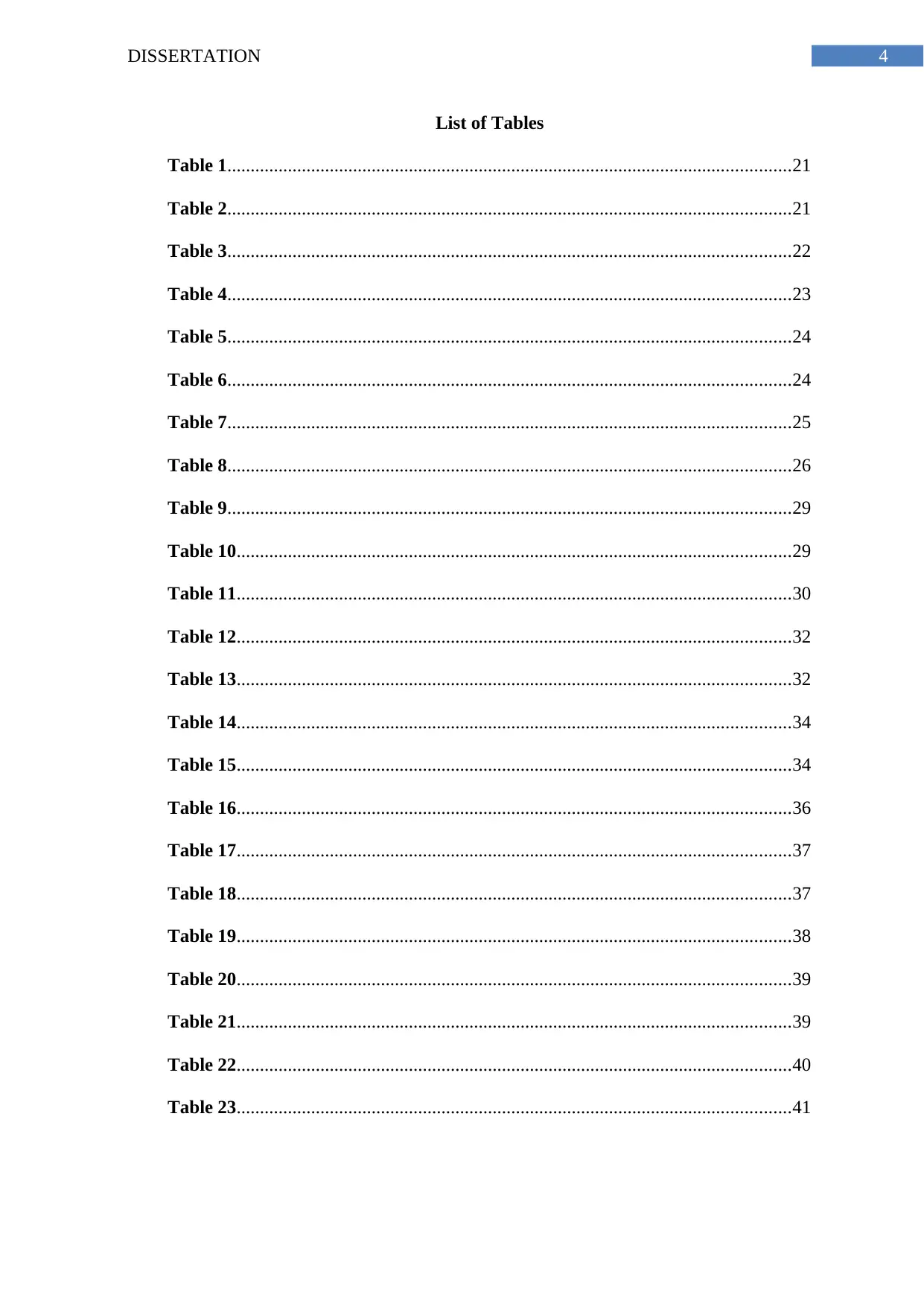
4DISSERTATION
List of Tables
Table 1.........................................................................................................................21
Table 2.........................................................................................................................21
Table 3.........................................................................................................................22
Table 4.........................................................................................................................23
Table 5.........................................................................................................................24
Table 6.........................................................................................................................24
Table 7.........................................................................................................................25
Table 8.........................................................................................................................26
Table 9.........................................................................................................................29
Table 10.......................................................................................................................29
Table 11.......................................................................................................................30
Table 12.......................................................................................................................32
Table 13.......................................................................................................................32
Table 14.......................................................................................................................34
Table 15.......................................................................................................................34
Table 16.......................................................................................................................36
Table 17.......................................................................................................................37
Table 18.......................................................................................................................37
Table 19.......................................................................................................................38
Table 20.......................................................................................................................39
Table 21.......................................................................................................................39
Table 22.......................................................................................................................40
Table 23.......................................................................................................................41
List of Tables
Table 1.........................................................................................................................21
Table 2.........................................................................................................................21
Table 3.........................................................................................................................22
Table 4.........................................................................................................................23
Table 5.........................................................................................................................24
Table 6.........................................................................................................................24
Table 7.........................................................................................................................25
Table 8.........................................................................................................................26
Table 9.........................................................................................................................29
Table 10.......................................................................................................................29
Table 11.......................................................................................................................30
Table 12.......................................................................................................................32
Table 13.......................................................................................................................32
Table 14.......................................................................................................................34
Table 15.......................................................................................................................34
Table 16.......................................................................................................................36
Table 17.......................................................................................................................37
Table 18.......................................................................................................................37
Table 19.......................................................................................................................38
Table 20.......................................................................................................................39
Table 21.......................................................................................................................39
Table 22.......................................................................................................................40
Table 23.......................................................................................................................41
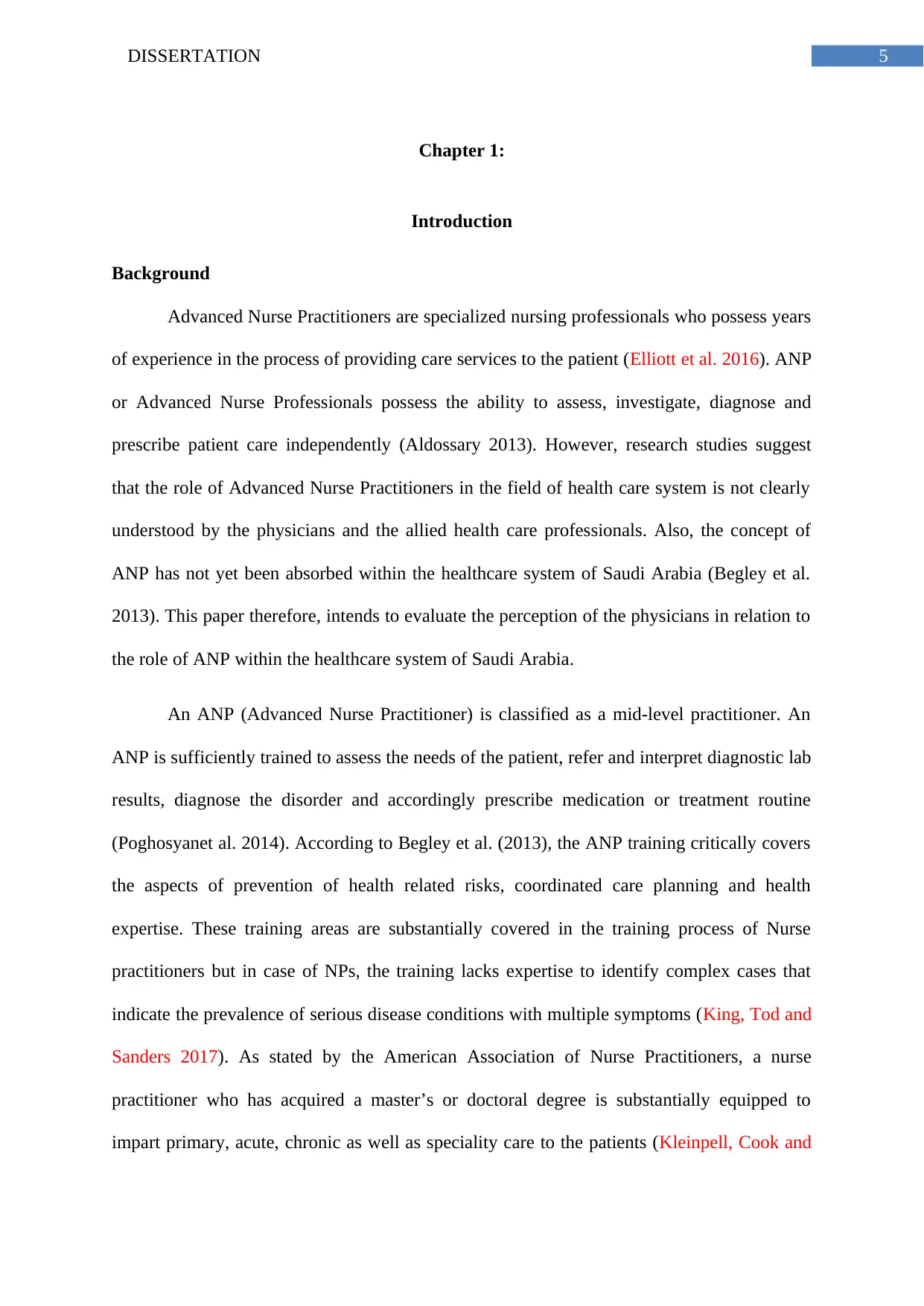
5DISSERTATION
Chapter 1:
Introduction
Background
Advanced Nurse Practitioners are specialized nursing professionals who possess years
of experience in the process of providing care services to the patient (Elliott et al. 2016). ANP
or Advanced Nurse Professionals possess the ability to assess, investigate, diagnose and
prescribe patient care independently (Aldossary 2013). However, research studies suggest
that the role of Advanced Nurse Practitioners in the field of health care system is not clearly
understood by the physicians and the allied health care professionals. Also, the concept of
ANP has not yet been absorbed within the healthcare system of Saudi Arabia (Begley et al.
2013). This paper therefore, intends to evaluate the perception of the physicians in relation to
the role of ANP within the healthcare system of Saudi Arabia.
An ANP (Advanced Nurse Practitioner) is classified as a mid-level practitioner. An
ANP is sufficiently trained to assess the needs of the patient, refer and interpret diagnostic lab
results, diagnose the disorder and accordingly prescribe medication or treatment routine
(Poghosyanet al. 2014). According to Begley et al. (2013), the ANP training critically covers
the aspects of prevention of health related risks, coordinated care planning and health
expertise. These training areas are substantially covered in the training process of Nurse
practitioners but in case of NPs, the training lacks expertise to identify complex cases that
indicate the prevalence of serious disease conditions with multiple symptoms (King, Tod and
Sanders 2017). As stated by the American Association of Nurse Practitioners, a nurse
practitioner who has acquired a master’s or doctoral degree is substantially equipped to
impart primary, acute, chronic as well as speciality care to the patients (Kleinpell, Cook and
Chapter 1:
Introduction
Background
Advanced Nurse Practitioners are specialized nursing professionals who possess years
of experience in the process of providing care services to the patient (Elliott et al. 2016). ANP
or Advanced Nurse Professionals possess the ability to assess, investigate, diagnose and
prescribe patient care independently (Aldossary 2013). However, research studies suggest
that the role of Advanced Nurse Practitioners in the field of health care system is not clearly
understood by the physicians and the allied health care professionals. Also, the concept of
ANP has not yet been absorbed within the healthcare system of Saudi Arabia (Begley et al.
2013). This paper therefore, intends to evaluate the perception of the physicians in relation to
the role of ANP within the healthcare system of Saudi Arabia.
An ANP (Advanced Nurse Practitioner) is classified as a mid-level practitioner. An
ANP is sufficiently trained to assess the needs of the patient, refer and interpret diagnostic lab
results, diagnose the disorder and accordingly prescribe medication or treatment routine
(Poghosyanet al. 2014). According to Begley et al. (2013), the ANP training critically covers
the aspects of prevention of health related risks, coordinated care planning and health
expertise. These training areas are substantially covered in the training process of Nurse
practitioners but in case of NPs, the training lacks expertise to identify complex cases that
indicate the prevalence of serious disease conditions with multiple symptoms (King, Tod and
Sanders 2017). As stated by the American Association of Nurse Practitioners, a nurse
practitioner who has acquired a master’s or doctoral degree is substantially equipped to
impart primary, acute, chronic as well as speciality care to the patients (Kleinpell, Cook and
⊘ This is a preview!⊘
Do you want full access?
Subscribe today to unlock all pages.

Trusted by 1+ million students worldwide
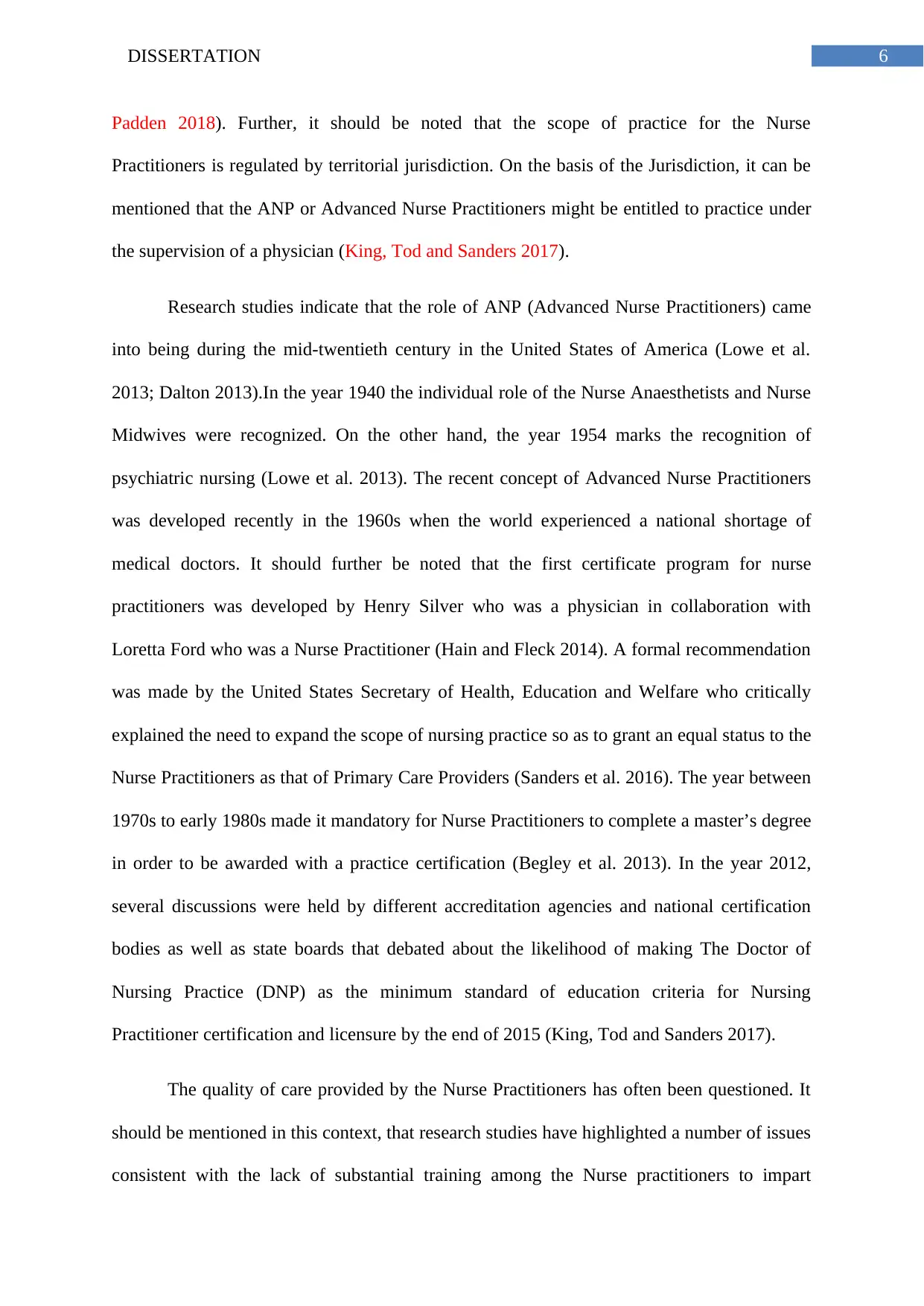
6DISSERTATION
Padden 2018). Further, it should be noted that the scope of practice for the Nurse
Practitioners is regulated by territorial jurisdiction. On the basis of the Jurisdiction, it can be
mentioned that the ANP or Advanced Nurse Practitioners might be entitled to practice under
the supervision of a physician (King, Tod and Sanders 2017).
Research studies indicate that the role of ANP (Advanced Nurse Practitioners) came
into being during the mid-twentieth century in the United States of America (Lowe et al.
2013; Dalton 2013).In the year 1940 the individual role of the Nurse Anaesthetists and Nurse
Midwives were recognized. On the other hand, the year 1954 marks the recognition of
psychiatric nursing (Lowe et al. 2013). The recent concept of Advanced Nurse Practitioners
was developed recently in the 1960s when the world experienced a national shortage of
medical doctors. It should further be noted that the first certificate program for nurse
practitioners was developed by Henry Silver who was a physician in collaboration with
Loretta Ford who was a Nurse Practitioner (Hain and Fleck 2014). A formal recommendation
was made by the United States Secretary of Health, Education and Welfare who critically
explained the need to expand the scope of nursing practice so as to grant an equal status to the
Nurse Practitioners as that of Primary Care Providers (Sanders et al. 2016). The year between
1970s to early 1980s made it mandatory for Nurse Practitioners to complete a master’s degree
in order to be awarded with a practice certification (Begley et al. 2013). In the year 2012,
several discussions were held by different accreditation agencies and national certification
bodies as well as state boards that debated about the likelihood of making The Doctor of
Nursing Practice (DNP) as the minimum standard of education criteria for Nursing
Practitioner certification and licensure by the end of 2015 (King, Tod and Sanders 2017).
The quality of care provided by the Nurse Practitioners has often been questioned. It
should be mentioned in this context, that research studies have highlighted a number of issues
consistent with the lack of substantial training among the Nurse practitioners to impart
Padden 2018). Further, it should be noted that the scope of practice for the Nurse
Practitioners is regulated by territorial jurisdiction. On the basis of the Jurisdiction, it can be
mentioned that the ANP or Advanced Nurse Practitioners might be entitled to practice under
the supervision of a physician (King, Tod and Sanders 2017).
Research studies indicate that the role of ANP (Advanced Nurse Practitioners) came
into being during the mid-twentieth century in the United States of America (Lowe et al.
2013; Dalton 2013).In the year 1940 the individual role of the Nurse Anaesthetists and Nurse
Midwives were recognized. On the other hand, the year 1954 marks the recognition of
psychiatric nursing (Lowe et al. 2013). The recent concept of Advanced Nurse Practitioners
was developed recently in the 1960s when the world experienced a national shortage of
medical doctors. It should further be noted that the first certificate program for nurse
practitioners was developed by Henry Silver who was a physician in collaboration with
Loretta Ford who was a Nurse Practitioner (Hain and Fleck 2014). A formal recommendation
was made by the United States Secretary of Health, Education and Welfare who critically
explained the need to expand the scope of nursing practice so as to grant an equal status to the
Nurse Practitioners as that of Primary Care Providers (Sanders et al. 2016). The year between
1970s to early 1980s made it mandatory for Nurse Practitioners to complete a master’s degree
in order to be awarded with a practice certification (Begley et al. 2013). In the year 2012,
several discussions were held by different accreditation agencies and national certification
bodies as well as state boards that debated about the likelihood of making The Doctor of
Nursing Practice (DNP) as the minimum standard of education criteria for Nursing
Practitioner certification and licensure by the end of 2015 (King, Tod and Sanders 2017).
The quality of care provided by the Nurse Practitioners has often been questioned. It
should be mentioned in this context, that research studies have highlighted a number of issues
consistent with the lack of substantial training among the Nurse practitioners to impart
Paraphrase This Document
Need a fresh take? Get an instant paraphrase of this document with our AI Paraphraser
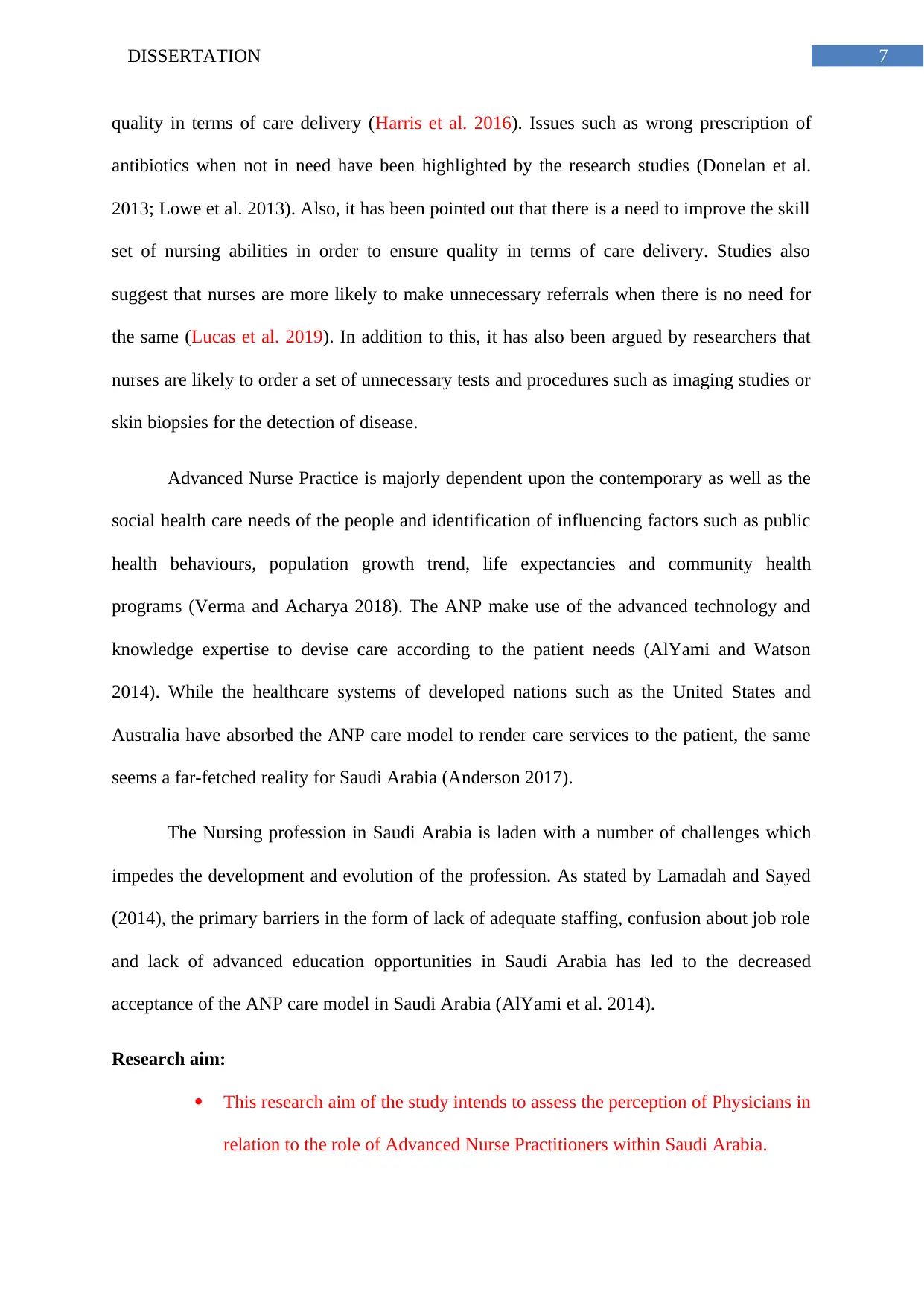
7DISSERTATION
quality in terms of care delivery (Harris et al. 2016). Issues such as wrong prescription of
antibiotics when not in need have been highlighted by the research studies (Donelan et al.
2013; Lowe et al. 2013). Also, it has been pointed out that there is a need to improve the skill
set of nursing abilities in order to ensure quality in terms of care delivery. Studies also
suggest that nurses are more likely to make unnecessary referrals when there is no need for
the same (Lucas et al. 2019). In addition to this, it has also been argued by researchers that
nurses are likely to order a set of unnecessary tests and procedures such as imaging studies or
skin biopsies for the detection of disease.
Advanced Nurse Practice is majorly dependent upon the contemporary as well as the
social health care needs of the people and identification of influencing factors such as public
health behaviours, population growth trend, life expectancies and community health
programs (Verma and Acharya 2018). The ANP make use of the advanced technology and
knowledge expertise to devise care according to the patient needs (AlYami and Watson
2014). While the healthcare systems of developed nations such as the United States and
Australia have absorbed the ANP care model to render care services to the patient, the same
seems a far-fetched reality for Saudi Arabia (Anderson 2017).
The Nursing profession in Saudi Arabia is laden with a number of challenges which
impedes the development and evolution of the profession. As stated by Lamadah and Sayed
(2014), the primary barriers in the form of lack of adequate staffing, confusion about job role
and lack of advanced education opportunities in Saudi Arabia has led to the decreased
acceptance of the ANP care model in Saudi Arabia (AlYami et al. 2014).
Research aim:
This research aim of the study intends to assess the perception of Physicians in
relation to the role of Advanced Nurse Practitioners within Saudi Arabia.
quality in terms of care delivery (Harris et al. 2016). Issues such as wrong prescription of
antibiotics when not in need have been highlighted by the research studies (Donelan et al.
2013; Lowe et al. 2013). Also, it has been pointed out that there is a need to improve the skill
set of nursing abilities in order to ensure quality in terms of care delivery. Studies also
suggest that nurses are more likely to make unnecessary referrals when there is no need for
the same (Lucas et al. 2019). In addition to this, it has also been argued by researchers that
nurses are likely to order a set of unnecessary tests and procedures such as imaging studies or
skin biopsies for the detection of disease.
Advanced Nurse Practice is majorly dependent upon the contemporary as well as the
social health care needs of the people and identification of influencing factors such as public
health behaviours, population growth trend, life expectancies and community health
programs (Verma and Acharya 2018). The ANP make use of the advanced technology and
knowledge expertise to devise care according to the patient needs (AlYami and Watson
2014). While the healthcare systems of developed nations such as the United States and
Australia have absorbed the ANP care model to render care services to the patient, the same
seems a far-fetched reality for Saudi Arabia (Anderson 2017).
The Nursing profession in Saudi Arabia is laden with a number of challenges which
impedes the development and evolution of the profession. As stated by Lamadah and Sayed
(2014), the primary barriers in the form of lack of adequate staffing, confusion about job role
and lack of advanced education opportunities in Saudi Arabia has led to the decreased
acceptance of the ANP care model in Saudi Arabia (AlYami et al. 2014).
Research aim:
This research aim of the study intends to assess the perception of Physicians in
relation to the role of Advanced Nurse Practitioners within Saudi Arabia.
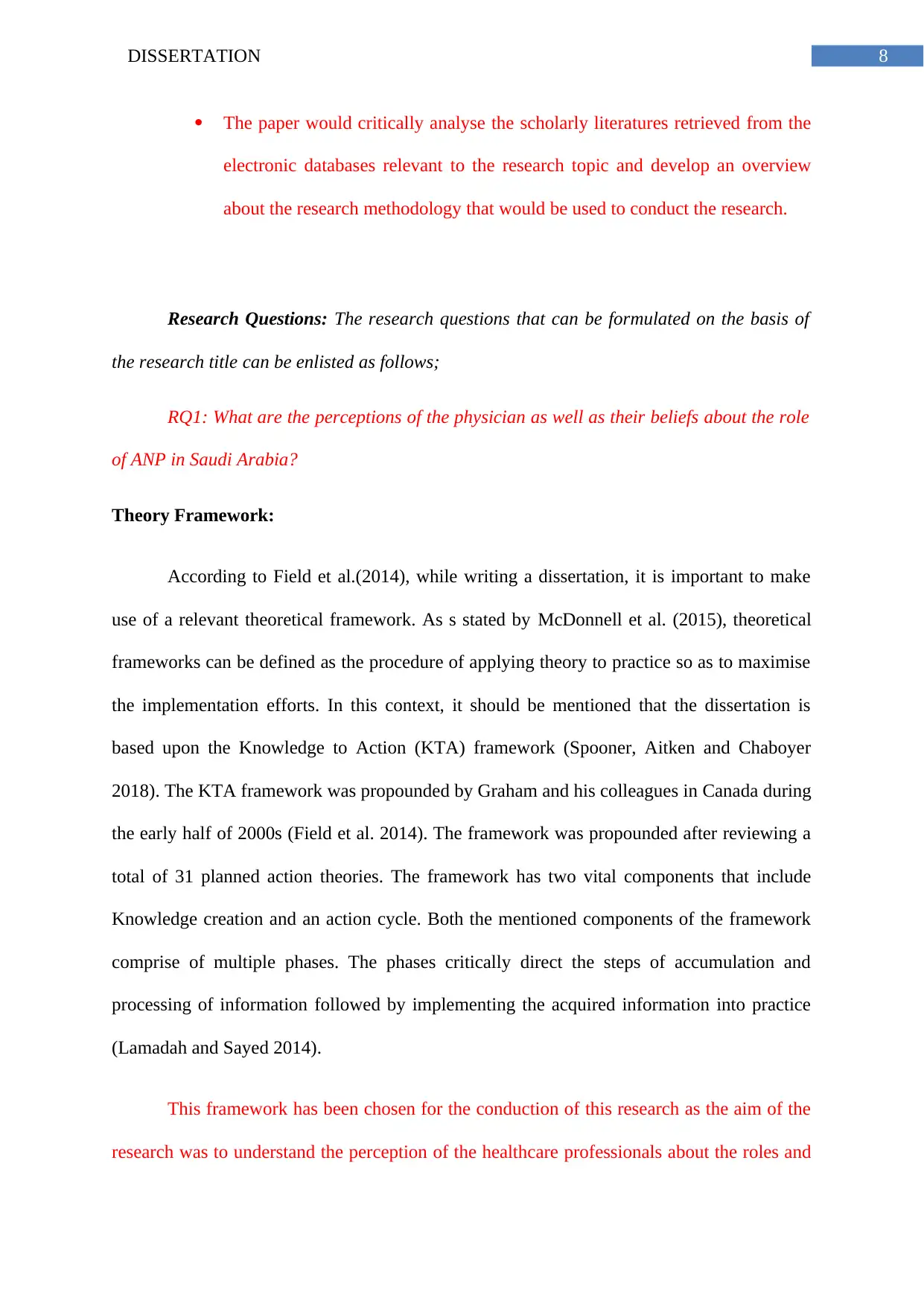
8DISSERTATION
The paper would critically analyse the scholarly literatures retrieved from the
electronic databases relevant to the research topic and develop an overview
about the research methodology that would be used to conduct the research.
Research Questions: The research questions that can be formulated on the basis of
the research title can be enlisted as follows;
RQ1: What are the perceptions of the physician as well as their beliefs about the role
of ANP in Saudi Arabia?
Theory Framework:
According to Field et al.(2014), while writing a dissertation, it is important to make
use of a relevant theoretical framework. As s stated by McDonnell et al. (2015), theoretical
frameworks can be defined as the procedure of applying theory to practice so as to maximise
the implementation efforts. In this context, it should be mentioned that the dissertation is
based upon the Knowledge to Action (KTA) framework (Spooner, Aitken and Chaboyer
2018). The KTA framework was propounded by Graham and his colleagues in Canada during
the early half of 2000s (Field et al. 2014). The framework was propounded after reviewing a
total of 31 planned action theories. The framework has two vital components that include
Knowledge creation and an action cycle. Both the mentioned components of the framework
comprise of multiple phases. The phases critically direct the steps of accumulation and
processing of information followed by implementing the acquired information into practice
(Lamadah and Sayed 2014).
This framework has been chosen for the conduction of this research as the aim of the
research was to understand the perception of the healthcare professionals about the roles and
The paper would critically analyse the scholarly literatures retrieved from the
electronic databases relevant to the research topic and develop an overview
about the research methodology that would be used to conduct the research.
Research Questions: The research questions that can be formulated on the basis of
the research title can be enlisted as follows;
RQ1: What are the perceptions of the physician as well as their beliefs about the role
of ANP in Saudi Arabia?
Theory Framework:
According to Field et al.(2014), while writing a dissertation, it is important to make
use of a relevant theoretical framework. As s stated by McDonnell et al. (2015), theoretical
frameworks can be defined as the procedure of applying theory to practice so as to maximise
the implementation efforts. In this context, it should be mentioned that the dissertation is
based upon the Knowledge to Action (KTA) framework (Spooner, Aitken and Chaboyer
2018). The KTA framework was propounded by Graham and his colleagues in Canada during
the early half of 2000s (Field et al. 2014). The framework was propounded after reviewing a
total of 31 planned action theories. The framework has two vital components that include
Knowledge creation and an action cycle. Both the mentioned components of the framework
comprise of multiple phases. The phases critically direct the steps of accumulation and
processing of information followed by implementing the acquired information into practice
(Lamadah and Sayed 2014).
This framework has been chosen for the conduction of this research as the aim of the
research was to understand the perception of the healthcare professionals about the roles and
⊘ This is a preview!⊘
Do you want full access?
Subscribe today to unlock all pages.

Trusted by 1+ million students worldwide
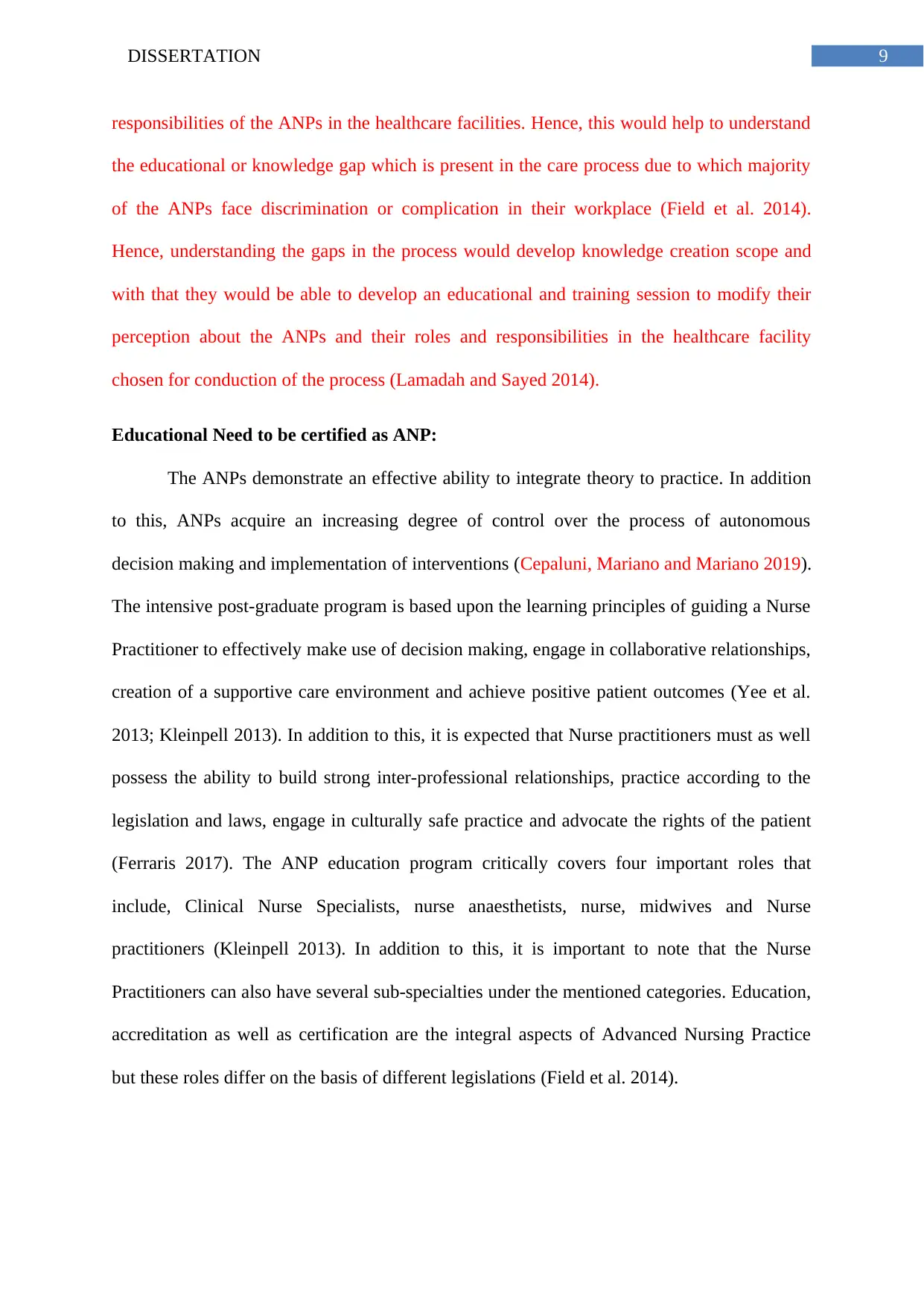
9DISSERTATION
responsibilities of the ANPs in the healthcare facilities. Hence, this would help to understand
the educational or knowledge gap which is present in the care process due to which majority
of the ANPs face discrimination or complication in their workplace (Field et al. 2014).
Hence, understanding the gaps in the process would develop knowledge creation scope and
with that they would be able to develop an educational and training session to modify their
perception about the ANPs and their roles and responsibilities in the healthcare facility
chosen for conduction of the process (Lamadah and Sayed 2014).
Educational Need to be certified as ANP:
The ANPs demonstrate an effective ability to integrate theory to practice. In addition
to this, ANPs acquire an increasing degree of control over the process of autonomous
decision making and implementation of interventions (Cepaluni, Mariano and Mariano 2019).
The intensive post-graduate program is based upon the learning principles of guiding a Nurse
Practitioner to effectively make use of decision making, engage in collaborative relationships,
creation of a supportive care environment and achieve positive patient outcomes (Yee et al.
2013; Kleinpell 2013). In addition to this, it is expected that Nurse practitioners must as well
possess the ability to build strong inter-professional relationships, practice according to the
legislation and laws, engage in culturally safe practice and advocate the rights of the patient
(Ferraris 2017). The ANP education program critically covers four important roles that
include, Clinical Nurse Specialists, nurse anaesthetists, nurse, midwives and Nurse
practitioners (Kleinpell 2013). In addition to this, it is important to note that the Nurse
Practitioners can also have several sub-specialties under the mentioned categories. Education,
accreditation as well as certification are the integral aspects of Advanced Nursing Practice
but these roles differ on the basis of different legislations (Field et al. 2014).
responsibilities of the ANPs in the healthcare facilities. Hence, this would help to understand
the educational or knowledge gap which is present in the care process due to which majority
of the ANPs face discrimination or complication in their workplace (Field et al. 2014).
Hence, understanding the gaps in the process would develop knowledge creation scope and
with that they would be able to develop an educational and training session to modify their
perception about the ANPs and their roles and responsibilities in the healthcare facility
chosen for conduction of the process (Lamadah and Sayed 2014).
Educational Need to be certified as ANP:
The ANPs demonstrate an effective ability to integrate theory to practice. In addition
to this, ANPs acquire an increasing degree of control over the process of autonomous
decision making and implementation of interventions (Cepaluni, Mariano and Mariano 2019).
The intensive post-graduate program is based upon the learning principles of guiding a Nurse
Practitioner to effectively make use of decision making, engage in collaborative relationships,
creation of a supportive care environment and achieve positive patient outcomes (Yee et al.
2013; Kleinpell 2013). In addition to this, it is expected that Nurse practitioners must as well
possess the ability to build strong inter-professional relationships, practice according to the
legislation and laws, engage in culturally safe practice and advocate the rights of the patient
(Ferraris 2017). The ANP education program critically covers four important roles that
include, Clinical Nurse Specialists, nurse anaesthetists, nurse, midwives and Nurse
practitioners (Kleinpell 2013). In addition to this, it is important to note that the Nurse
Practitioners can also have several sub-specialties under the mentioned categories. Education,
accreditation as well as certification are the integral aspects of Advanced Nursing Practice
but these roles differ on the basis of different legislations (Field et al. 2014).
Paraphrase This Document
Need a fresh take? Get an instant paraphrase of this document with our AI Paraphraser
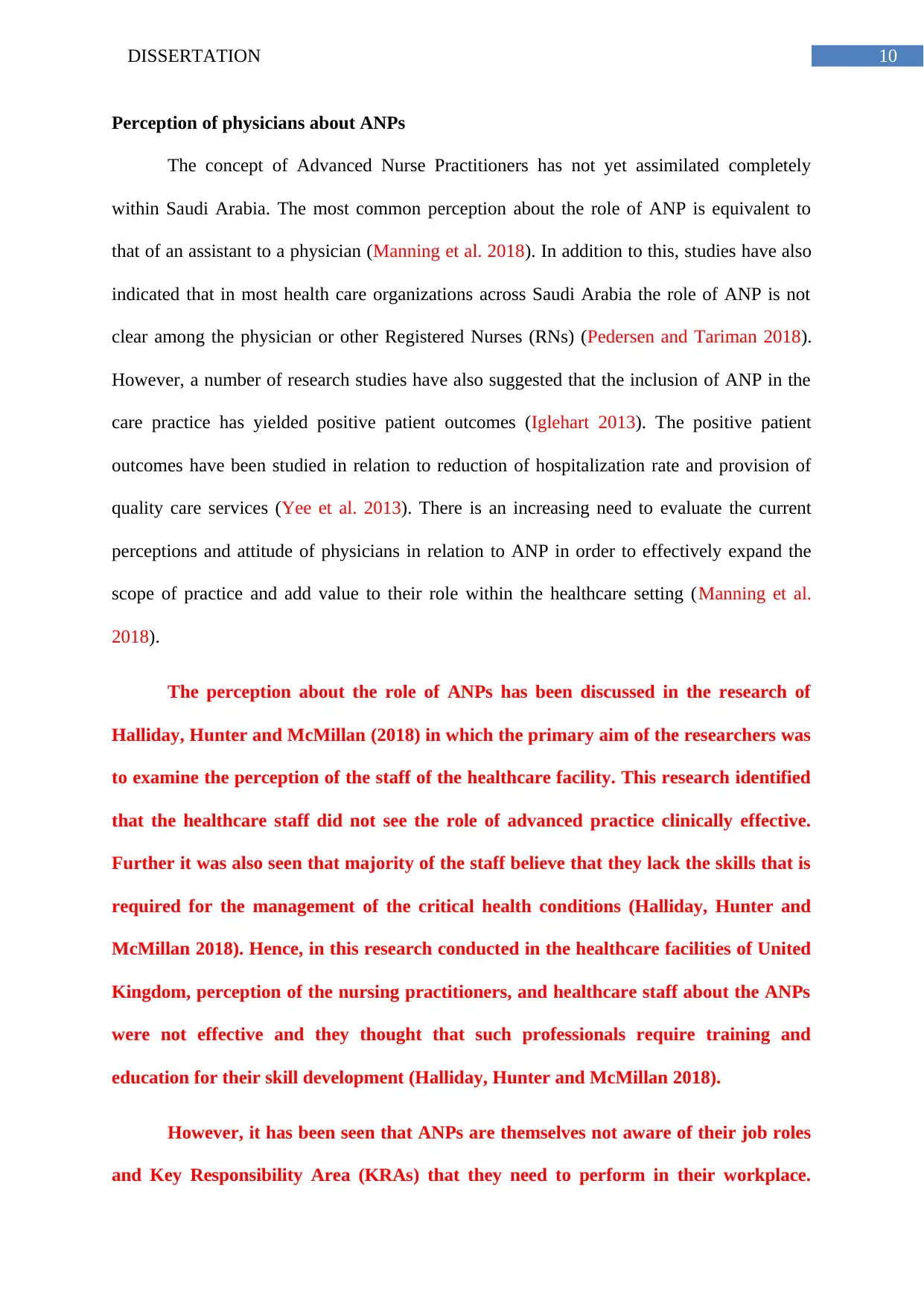
10DISSERTATION
Perception of physicians about ANPs
The concept of Advanced Nurse Practitioners has not yet assimilated completely
within Saudi Arabia. The most common perception about the role of ANP is equivalent to
that of an assistant to a physician (Manning et al. 2018). In addition to this, studies have also
indicated that in most health care organizations across Saudi Arabia the role of ANP is not
clear among the physician or other Registered Nurses (RNs) (Pedersen and Tariman 2018).
However, a number of research studies have also suggested that the inclusion of ANP in the
care practice has yielded positive patient outcomes (Iglehart 2013). The positive patient
outcomes have been studied in relation to reduction of hospitalization rate and provision of
quality care services (Yee et al. 2013). There is an increasing need to evaluate the current
perceptions and attitude of physicians in relation to ANP in order to effectively expand the
scope of practice and add value to their role within the healthcare setting (Manning et al.
2018).
The perception about the role of ANPs has been discussed in the research of
Halliday, Hunter and McMillan (2018) in which the primary aim of the researchers was
to examine the perception of the staff of the healthcare facility. This research identified
that the healthcare staff did not see the role of advanced practice clinically effective.
Further it was also seen that majority of the staff believe that they lack the skills that is
required for the management of the critical health conditions (Halliday, Hunter and
McMillan 2018). Hence, in this research conducted in the healthcare facilities of United
Kingdom, perception of the nursing practitioners, and healthcare staff about the ANPs
were not effective and they thought that such professionals require training and
education for their skill development (Halliday, Hunter and McMillan 2018).
However, it has been seen that ANPs are themselves not aware of their job roles
and Key Responsibility Area (KRAs) that they need to perform in their workplace.
Perception of physicians about ANPs
The concept of Advanced Nurse Practitioners has not yet assimilated completely
within Saudi Arabia. The most common perception about the role of ANP is equivalent to
that of an assistant to a physician (Manning et al. 2018). In addition to this, studies have also
indicated that in most health care organizations across Saudi Arabia the role of ANP is not
clear among the physician or other Registered Nurses (RNs) (Pedersen and Tariman 2018).
However, a number of research studies have also suggested that the inclusion of ANP in the
care practice has yielded positive patient outcomes (Iglehart 2013). The positive patient
outcomes have been studied in relation to reduction of hospitalization rate and provision of
quality care services (Yee et al. 2013). There is an increasing need to evaluate the current
perceptions and attitude of physicians in relation to ANP in order to effectively expand the
scope of practice and add value to their role within the healthcare setting (Manning et al.
2018).
The perception about the role of ANPs has been discussed in the research of
Halliday, Hunter and McMillan (2018) in which the primary aim of the researchers was
to examine the perception of the staff of the healthcare facility. This research identified
that the healthcare staff did not see the role of advanced practice clinically effective.
Further it was also seen that majority of the staff believe that they lack the skills that is
required for the management of the critical health conditions (Halliday, Hunter and
McMillan 2018). Hence, in this research conducted in the healthcare facilities of United
Kingdom, perception of the nursing practitioners, and healthcare staff about the ANPs
were not effective and they thought that such professionals require training and
education for their skill development (Halliday, Hunter and McMillan 2018).
However, it has been seen that ANPs are themselves not aware of their job roles
and Key Responsibility Area (KRAs) that they need to perform in their workplace.
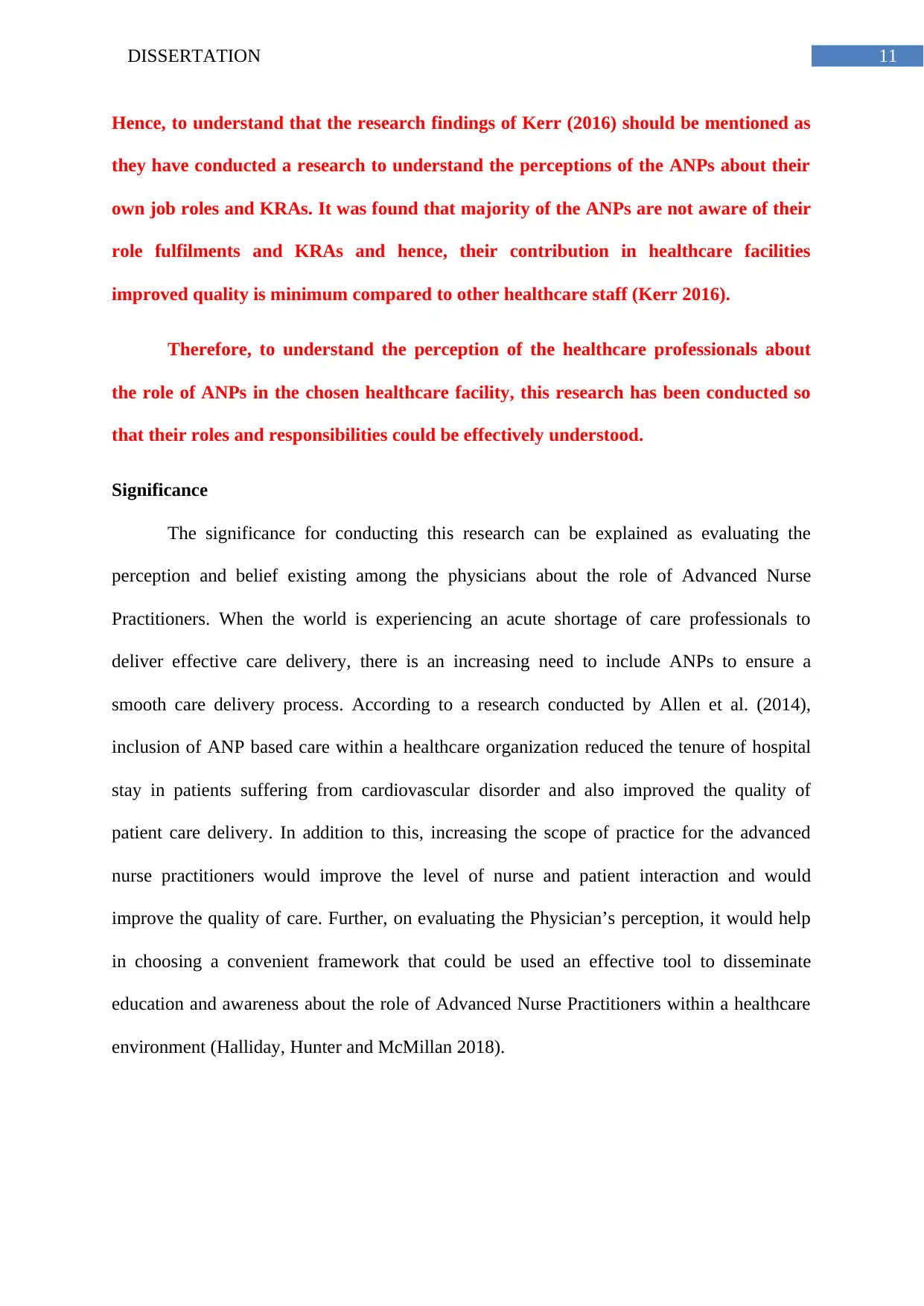
11DISSERTATION
Hence, to understand that the research findings of Kerr (2016) should be mentioned as
they have conducted a research to understand the perceptions of the ANPs about their
own job roles and KRAs. It was found that majority of the ANPs are not aware of their
role fulfilments and KRAs and hence, their contribution in healthcare facilities
improved quality is minimum compared to other healthcare staff (Kerr 2016).
Therefore, to understand the perception of the healthcare professionals about
the role of ANPs in the chosen healthcare facility, this research has been conducted so
that their roles and responsibilities could be effectively understood.
Significance
The significance for conducting this research can be explained as evaluating the
perception and belief existing among the physicians about the role of Advanced Nurse
Practitioners. When the world is experiencing an acute shortage of care professionals to
deliver effective care delivery, there is an increasing need to include ANPs to ensure a
smooth care delivery process. According to a research conducted by Allen et al. (2014),
inclusion of ANP based care within a healthcare organization reduced the tenure of hospital
stay in patients suffering from cardiovascular disorder and also improved the quality of
patient care delivery. In addition to this, increasing the scope of practice for the advanced
nurse practitioners would improve the level of nurse and patient interaction and would
improve the quality of care. Further, on evaluating the Physician’s perception, it would help
in choosing a convenient framework that could be used an effective tool to disseminate
education and awareness about the role of Advanced Nurse Practitioners within a healthcare
environment (Halliday, Hunter and McMillan 2018).
Hence, to understand that the research findings of Kerr (2016) should be mentioned as
they have conducted a research to understand the perceptions of the ANPs about their
own job roles and KRAs. It was found that majority of the ANPs are not aware of their
role fulfilments and KRAs and hence, their contribution in healthcare facilities
improved quality is minimum compared to other healthcare staff (Kerr 2016).
Therefore, to understand the perception of the healthcare professionals about
the role of ANPs in the chosen healthcare facility, this research has been conducted so
that their roles and responsibilities could be effectively understood.
Significance
The significance for conducting this research can be explained as evaluating the
perception and belief existing among the physicians about the role of Advanced Nurse
Practitioners. When the world is experiencing an acute shortage of care professionals to
deliver effective care delivery, there is an increasing need to include ANPs to ensure a
smooth care delivery process. According to a research conducted by Allen et al. (2014),
inclusion of ANP based care within a healthcare organization reduced the tenure of hospital
stay in patients suffering from cardiovascular disorder and also improved the quality of
patient care delivery. In addition to this, increasing the scope of practice for the advanced
nurse practitioners would improve the level of nurse and patient interaction and would
improve the quality of care. Further, on evaluating the Physician’s perception, it would help
in choosing a convenient framework that could be used an effective tool to disseminate
education and awareness about the role of Advanced Nurse Practitioners within a healthcare
environment (Halliday, Hunter and McMillan 2018).
⊘ This is a preview!⊘
Do you want full access?
Subscribe today to unlock all pages.

Trusted by 1+ million students worldwide
1 out of 59
Related Documents
Your All-in-One AI-Powered Toolkit for Academic Success.
+13062052269
info@desklib.com
Available 24*7 on WhatsApp / Email
![[object Object]](/_next/static/media/star-bottom.7253800d.svg)
Unlock your academic potential
Copyright © 2020–2025 A2Z Services. All Rights Reserved. Developed and managed by ZUCOL.





